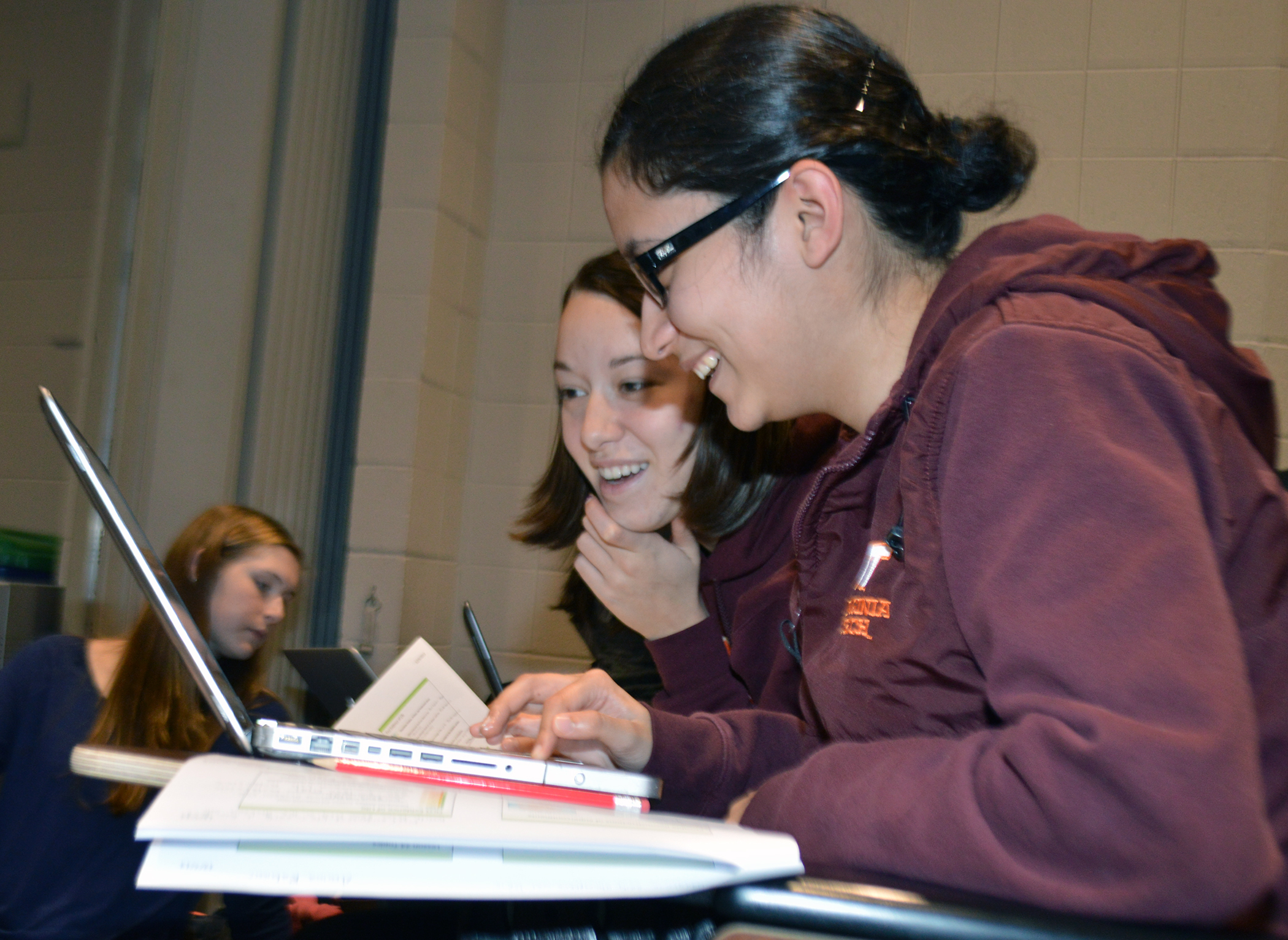Biological Sciences takes active approach to class instruction

Walk into a freshman Principles of Biology class and you’ll notice the students are all talking to each other, and the professor doesn’t mind a bit because they’re not being disruptive – they’re learning.
It’s an active classroom that made its biology debut at Virginia Tech in the fall 2013 semester and raises the bar as a way to make a big impact on a big class.
Funding for the redesign effort is from a partnership with the state, Cisco Systems, and the four universities that make up 4-VA: Virginia Tech, the University of Virginia, James Madison University, and George Mason University.
The schools chose programs they thought would work best for the initiative. College of Science faculty decided to revise selected introductory biology and math courses using the more than $700,000 over two years allotted to the project.
“This is a major curriculum refresh project that began in January 2013 and runs through the end of 2014,” said Rich Walker, an associate professor and associate department head of biological sciences. Walker oversees the biology redesign and Terri Bourdon, who leads the Math Emporium, is guiding revision of the math courses taken by biological sciences and other life science students.
For the Principles of Biology model, students view lectures on a computer and complete a short quiz to reinforce lecture content before coming to class. Class time is spent with a short review of important lecture topics followed by an active learning project. The instructor and trained undergraduate teaching assistants help the small groups by providing guidance and oversight.
About 400 students took part in two pilot sections during the fall semester. Working in teams of four, they participate in activities they download from Scholar, Walker explained.
The results of the first semester were encouraging.
“Over the years as lecture class size has grown, we’ve found students bringing laptops to class and promptly disappearing into their virtual lives,” said Michael Rosenzweig, an advanced biological science instructor and the department’s bioscience outreach program director and principles of biology instructor. “This made it imperative we find ways to engage students. Every student I’ve seen privately has said that while they weren’t expecting this type of environment, it has ended up helping them learn.”
Rosenzweig said student performance has risen over previous years, but admits it’s too early to reach any conclusions.
“Working in small groups gives the students a more realistic flavor of how they’ll work in their careers,” he said. “They won’t be passively listening to a lecturer, but working on problems, sometimes with total strangers or people they don’t expect to work with or get along with. And I’m no longer an anonymous figurehead at the front of the lecture hall. I’m having a lot of fun walking around and interacting with students, answering questions, reviewing material, and getting to know them in a way that’s not possible in a traditional classroom.”
The program will be adjusted as it is introduced to more areas in the curriculum, said Walker, and while it will certainly benefit the instructors, ultimately the value will be to the students.
The new system makes for a more consistent workflow for students, unlike the passive valleys and study peaks that occur before exams in a more traditional class environment.
“Those peaks and valleys are hard on students and instructors,” Walker explained. Prior to exams, “Instructors spend many hours in meeting with students and covering the same material over and over again. However, there are still challenges with the new approach. Getting people to work in groups takes time. It also takes time to convince some people their grade isn’t being determined by someone else. But science isn’t just answering multiple choice questions or memorizing facts and figures. We’re trying to move more toward what a scientist actually does.”
In addition to allowing increased interaction between instructor and student, the online lectures also become a review library for upper level students. Those entering sophomore classes will be able to start at a higher level because the review material will always be available and less time will be spent in class reviewing the previous semester’s or year’s work.
“Over the last 10 years there have been a lot of national calls for changes to undergraduate biological sciences education,” said Brenda Winkel, head of the Department of Biological Sciences. “A more active approach that mimics what biologists actually do is needed and it’s a challenge based on the number of students. The scale of what we’re trying to do makes this stand out; eventually we’ll put 1,300 or more students per year through this program.”
In addition, developing the active classroom has Walker looking at the department’s biology laboratory classes in an effort to move to more discovery-based work.
“We’d like to continue our ongoing progression from cookbook labs where students follow precise instructions, to engaging students in real research,” Walker said. “Science is about asking questions, not following a recipe and that’s a key to get students into STEM, when they realize it’s not about memorization. Many biological sciences majors are interested in health careers or graduate school but those are getting more and more difficult to get into. We need to provide hands-on opportunities and problem solving which helps students find employment after graduation.
“We want to get students to go from passive to active thinkers and think like scientists,” he said. “With Terri Bourdon’s leadership, another goal is to put a biological context into the math so students aren’t sitting there thinking, ‘What does this have to do with biology?’ It has a lot to do with it; and if we can change the curriculum a bit to make those connections it will help the students.”
And helping students work together, learn, and be more prepared for life after classes is a goal worth actively pursuing.




